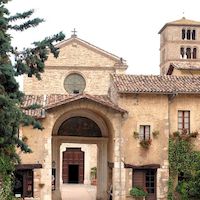Farfa Abbey
One of our favourite places to visit near La Torricella is Farfa Abbey, just 15 minutes away. We love the beautiful scenery, medieval and Renaissance buildings and tiny cobbled streets in the "borgo".
There are also artisans selling gorgeous textiles, soaps, ceramics and baked goods, and pots of tumbling flowers everywhere.
Situated on a tributary of the Tiber River, the Farfa, at the foot of Mt Acuziano, the hamlet of Farfa is tiny but bursting with character. The hamlet sprung up near the famous Abbey and has terraced houses with ground floors orginally used by Benedictine monks during the great market fairs during the Middle Ages which were held from April to September.
Artisans still sell their wares in some of these shops, as they were all restored 100 years ago.
The Farfa markets were very popular and people from all over central Italy would come here. Farfa Abbey was one of the most famous and powerful monasteries of the Middle Ages, and much of central Italy was subject to it. The Abbey was founded over a Roman farm and paleochristian basilica in the 5th or 6th century BC and was rebuilt in 680 AD by St Thomas from Moriana with the help of the Duke of Spoleto and Pope John 7th.
Charlemagne had it under his own direct administrative control and visited the abbey for a month of his way to be crowned Holy Roman Emperor by Pope Leo 3rd in 800. The Farfa church was restored in the Renaissance and has a beautiful carved wooden ceiling commissioned by the Orsini family.
There is a guided tour of the Abbey buildings. There is beautiful old pharmacy where you can buy gifts including beautiful honey & olive oil soaps, rosaries, cosmetics and liqueurs. There are still artisans selling their wares in the hamlet, such as an incredible linen shop, ceramics and baked goods. There are also monthly antique markets held here on weekends.
On the way back to the villa you may also like to see the quaint medieval church of Santa Vittoria in Monteleone village and the nearby ancient Roman ruins of Trebula Mutusca including a 2nd century anfitheatre. Emperor Vespasian who built the Colosseum, came from the Sabina area, and the DOP grade olive oil from the region has been famous since Roman times.








